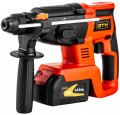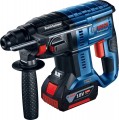Impact energy
The energy transmitted by the perforator to the material being processed upon impact; the higher this indicator, the stronger and more powerful each individual blow.
First of all, we recall that the energy of impacts is directly related to their frequency: an increase in frequency leads to a decrease in energy. Therefore, for models where the number of strokes can be adjusted, this paragraph usually gives the maximum energy achieved at the minimum speed of operation.
In general, higher impact energy improves efficiency when working with hard, stubborn materials, but requires more motor power (especially if it has to be combined with a high frequency). Therefore, it is worth choosing according to this parameter, taking into account specific tasks. So, for occasional use in everyday life, an energy of 2 J or less is enough, for home repair work of medium intensity, at least 3 J is desirable; a power of
4 J or more is already considered high; and in some industrial-grade perforators, this figure can reach 30 J.
Number of thrusts
The number of beats per minute provided by the punch. For models in which the beat frequency can be adjusted, this item indicates the entire adjustment range, for example "1600 — 3000".
High impact frequency, on the one hand, increases the productivity of the tool and can significantly reduce the time required for work. On the other hand, with the same engine power, an increase in the number of strokes per minute leads to a decrease in the energy of each stroke. Therefore, among heavy performant devices, a low frequency is often found — up to 2500 beats / min and even lower. And the ability to adjust the frequency of impacts allows you to adjust the hammer to the specific situation, depending on what is more important — productivity or the ability to cope with hard, stubborn material. For example, for old crumbling brickwork, you can set the speed higher, and for working with stone or dense concrete, it is better to reduce the frequency of impacts by directing engine power to increase the energy of each impact.
Summing up, we can say this: when choosing a perforator, you should focus on both the number of strokes and the impact energy. Detailed recommendations on this subject for specific situations can be found in special sources.
Rotation speed
The speed of rotation of the working equipment provided by the rotary hammer. Usually, this indicates the speed at idle, without load; rated load speeds can be further specified in the characteristics (see below), but this is rare, and this parameter is still considered the main characteristic. It is also worth mentioning that in the presence of a speed controller (see "Functions"), the maximum speed value is given here.
When working in the main mode — drilling with impact — the rotation of the equipment is used mainly to remove waste from the hole, and the revolutions here are of no fundamental importance (they can be very low). Therefore, it is worth paying attention to this indicator mainly in cases where the rotary hammer is planned to be often used for conventional drilling, without impact. And here it is worth proceeding from the fact that
high speeds increase productivity and contribute to accuracy when working with some materials, but reduce torque (compared to tools with the same engine power). So for heavy work with hard, stubborn materials, relatively "slow" tools are usually better suited.
Note also that drilling is not the main task of rotary hammers; therefore, their rotation speeds are noticeably lower than those of the same
drills. On the other hand, in this case, low speeds are often compensated by powerful engines and high torque, which makes it possible to effectively drill holes
...of a fairly large diameter, including using crowns.Wood drilling max. ⌀
The maximum diameter of a tool that can be used with a rotary hammer when drilling in wood (and, accordingly, the maximum diameter of the resulting hole). With a large drilling diameter, the loads on the device increase, and some models may simply not be designed for them (despite the technical possibility of installing tools of the appropriate diameter), as a result, it is not worth exceeding the maximum specified diameter, because. this may damage the instrument.
Concrete drilling max. ⌀
The maximum tool diameter that can be used with a rotary hammer when drilling in concrete. See "Maximum drilling diameter in wood" for details.
Battery type
The model of a standard battery allows you to find out its characteristics in more detail, and also helps you understand what devices it is like and which one should be purchased in case of a replacement due to a malfunction or, if necessary, buy another similar one.
Compatible batteries
The name of the battery that is compatible with the device. It helps to buy a spare or find a suitable one in case of a breakdown of the main one.
Charging time
The time required to fully charge the battery used in the tool using the standard charger.
For information on cordless tools in general, see “Power Source.” And charging time data allows you to estimate how you will have to organize your working hours and how long breaks you will need to charge your batteries. However, the specific meaning of this parameter also depends on the number of batteries included. Let us remind you that there are often several of them at once (see “Included battery”), and while one battery is working, the others can be charged. This allows you to reduce breaks to a minimum, or even do without them completely. But if there is only one battery, breaks for charging will inevitably be required in full, and
rotary hammers with fast battery charging will be very useful.
In box
—
Additional handle. The presence of an additional front handle on the hammer drill, usually located at the base of the chuck. This handle can be non-removable or removable, rigidly fixed or movable. Holding two handles with two hands is much more convenient than holding one and the body, as it allows for optimal distribution of the load on the hands; this is especially important during long-term work and processing of “heavy” materials.
—
Depth gauge. A device that allows you to make holes of a strictly defined depth in one go, without constant measurements and without the risk of drilling deeper than necessary. Usually looks like a rod fixed to the body of the hammer drill parallel to the working tool. When used, this rod extends to such a length that when the desired depth is reached, it rests against the surface of the material being processed, preventing the drill from moving further.
—
Chisel. Complete attachment for impact work with a hammer drill in the manner of chasing, leveling hard surfaces, chipping tiles, bricks, concrete, etc. Different types of chisels are produced for different tasks — flat, blade, groove, crushing peaks with a sharp tip.
—
Boring bit. The presence of Boring bit in the delivery set of tool designed for processing various hard materials by drilling with impact. Buying such a s
...et eliminates the need to look for a drill separately, but the characteristics of the complete attachment must be clarified before purchasing, since they may not meet the buyer's requirements.
— Charger. The presence of a charging unit in the kit allows you to charge batteries. Accordingly, for models with batteries, this accessory is necessary to power the battery. However, there are models without a charger. And hammer drills with it can differ in the model of the charger, the name of which will allow you to learn more about its characteristics and, if necessary or as needed (breakdown), buy a similar one.
— Case included. The delivery set includes a special case that facilitates storage and transportation: it provides protection from impacts and adverse conditions (moisture, frost), is equipped with a special handle for carrying, in addition, in the case, along with the hammer drill itself, a set of working tools, replacement cartridges, etc. can be placed.
— Dust collector. The hammer drill comes with a special dust collector. As the name suggests, it is designed to collect dust generated during operation, which could otherwise cause significant inconvenience. It usually looks like a bag or container attached to the body; it can be either replaceable (thrown away with the collected garbage) or permanent. The dust collector slightly increases the weight and dimensions of the hammer drill, but it can be removed if necessary.
